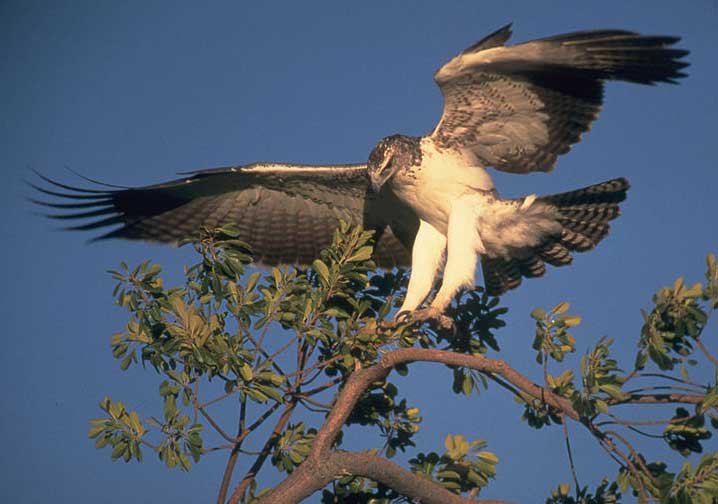
Polemaetus bellicosus (http://www.watzmann-pictures.de)
Cladus: Eukaryota
Supergroup: Opisthokonta
Regnum: Animalia
Subregnum: Eumetazoa
Cladus: Bilateria
Cladus: Nephrozoa
Cladus: Deuterostomia
Phylum: Chordata
Subphylum: Vertebrata
Infraphylum: Gnathostomata
Superclassis: Tetrapoda
Classis: Aves
Subclassis: Carinatae
Infraclassis: Neornithes
Parvclassis: Neognathae
Ordo: Falconiformes
Familia: Accipitridae
Subfamilia: Aquilinae
Genus: Polemaetus
Species: Polemaetus bellicosus
Name
Polemaetus bellicosus (Daudin, 1800)
References
* Traite élémentaire et complet d'Ornithologie 2 p.38
Vernacular names
Česky: Orel bojovný
Dansk: Kampørn
Deutsch: Kampfadler
English: Martial Eagle
Español: Águila Marcial
Français: Aigle martial
Italiano: Aquila marziale
Nederlands: Vechtarend
日本語: ゴマバラワシ
Polski: Wojownik zbrojny
The Martial Eagle (Polemaetus bellicosus), is a very large eagle found in open and semi-open habitats of sub-Saharan Africa. It is the only member of the genus Polemaetus.
Description
It is a very large eagle, with a length of 76–96 cm (30–38 in), weight of 3.1–6.2 kg (6.8–14 lb) and a wingspan of 188–227 cm (6.17–7.45 ft).[1] Among eagles found in Africa, only the Golden, Verreaux's and Crowned Eagle overlap in size with the Martial Eagle.[1] The adult's plumage has dark brown upperparts, head and upper chest. The body underparts are white spotted with black. The underwing coverts are brown, with pale flight feathers, also streaked with black. The female is usually larger and more spotted than the male. The immature is paler above and has white underparts. It reaches adult plumage in its seventh year.
Range and habitat
The Martial Eagle can be found in most of sub-Saharan Africa, wherever food is abundant and the environment favourable. It is never common, but greater population densities do exist in southern Africa, especially in Zimbabwe and South Africa. Generally, these birds are more abundant in protected areas such as Kruger National Park and Kgalagadi Transfrontier Park in South Africa, or Etosha National Park in Namibia.
Its preferred habitat is the semi-desert and open savannah. It avoids dense forests (such as the Guinean and Congolian forests), but needs trees to nest in. The territory can vary greatly in size from more than 1,000 km2 (390 sq mi) to areas where nests are less than 10 km (6.2 mi) distant. This disparity is due to differences in food supply.
Immature bird.
Diet
The diet of the Martial Eagle varies greatly with prey availability. Birds up to the size of a stork can be taken, but it more often chooses medium-sized ground-dwelling species such as francolins, guinea fowl or bustards. In some areas mammals constitute the greater part of its diet, with such species as hares, hyraxes, mongooses, baboons, young impalas and other small antelope. Adult duikers that comprise Martial Eagle prey can considerably outweigh, up to 37 kg (82 lbs) when taken, the eagles hunting them. Such prey is returned to repeatedly after the kill for feeding since it is too heavy to fly with.[2] It may also attack domestic livestock, including poultry, lambs and young goats, but this is never a great part of its diet.[3] Most prey items weigh between 1 and 5 kilograms (2.2 and 11 lb).[4]
The Martial Eagle hunts mostly in flight, circling high above its territory, and stooping sharply to catch its prey by surprise.
Young bird in Masai Mara, Kenya
Nesting
Martial Eagles have no distinctive display flight, but utter a loud cry 'klee-klee-klee-kloeee-kloeee-kuleee' during the mating period. They build their nests in trees but also (in the Karoo of South Africa) on electric-power pylons.[5] The nest is a huge construction, used year after year, measuring 2 m (6.6 ft) in diameter and 0.9 m (3.0 ft) deep. They have a slow breeding rate, laying at most one egg every two years. The egg is incubated for 45 days and the chick fledged at 100 days. Beyond this, despite becoming increasingly independent, juvenile birds will remain close to the nest for another 6 months.
Conservation issues
This species is currently experiencing a major decline in numbers, due to the over killing from hunters. Its conservation status was uplisted to Near Threatened in 2009 and another uplisting is already expected.[6] Martial Eagle suffers from persecution through shooting and poisoning, but also from indirect threats, such as collision with power-lines.[5] Another hazard is caused by steep sided farm reservoirs, in which many birds drown. In South Africa it may have lost 20% of its population in the last three generations.[7] In many areas where they come into contact with humans, eagle populations have decreased greatly through persecution, because they are blamed for killing livestock. In reality, domestic animals constitute only a small proportion of their diet, whereas the presence of eagles is a sure sign of a healthy environment. The preservation of this species depends on education of farmers, and the direct protection of nesting sites.
References
1. ^ a b Ferguson-Lees & Christie, Raptors of the World. Houghton Mifflin Company (2001), ISBN 978-0618127627
2. ^ Ferguson-Lees & Christie, Raptors of the World. Houghton Mifflin Company (2001), ISBN 978-0618127627
3. ^ Regional variation in the diet of martial eagles in the Cape Province, South Africa. Boshoff, AF; Palmer, NG; Avery, G(1990).
4. ^ Kemp, A. C. (1994). Martial Eagle (Polemaetus bellicosus). Pp. 200-201 in: del Hoyo, Elliott & Sargatal. eds. (1994). Handbook of the Birds of the World, vol. 2. ISBN 84-87334-15-6
5. ^ a b Electric eagles of the Karoo, Koos De Goede and Andrew Jenkins(2001).
6. ^ BirdLife International 2009. Polemaetus bellicosus. In: IUCN 2009. IUCN Red List of Threatened Species. Version 2009.2. <www.iucnredlist.org>. Downloaded on 13 January 2010.
7. ^ Barnes, KN (ed)(2000). The Eskom Red data book of birds of South Africa, Lesotho and Swaziland, Birdlife South Africa, Johannesburg. ISBN 0-620-25499-8
* BirdLife International (2009). Polemaetus bellicosus. In: IUCN 2010. IUCN Red List of Threatened Species. Version 2010.1. Downloaded on 9 April 2010.
* Leslie Brown & Dean Amadon(1989).Eagles Hawks & Falcons of the World, The Wellfleet Press. ISBN 1-55521-472-X
Retrieved from "http://en.wikipedia.org/"
All text is available under the terms of the GNU Free Documentation License

